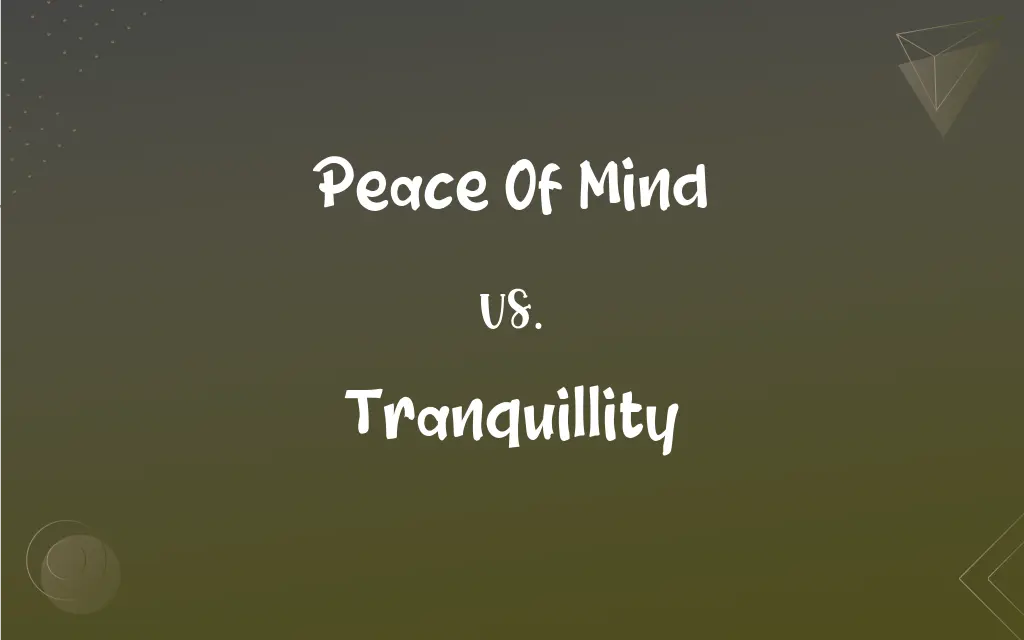Peace Of Mind vs. Tranquillity: What's the Difference?
Edited by Aimie Carlson || By Harlon Moss || Published on January 2, 2024
Peace of mind refers to a mental state of calmness or tranquility, free from worry or stress. Tranquillity is a state of physical or overall calmness, often quiet and undisturbed.

Key Differences
Peace of mind and tranquillity both denote states of calm, but their applications differ. Peace of mind is an internal, emotional state, characterized by freedom from worry or anxiety. It often involves mental and emotional stability. Tranquillity, on the other hand, usually refers to an external state of calmness, often associated with environments or settings that are serene and undisturbed.
When considering peace of mind, one often thinks of a psychological state achieved through mindfulness or mental health practices. It is a personal and subjective experience. Tranquillity, in contrast, is more about the absence of disturbance in the surrounding environment. It can be experienced in a quiet forest, a still lake, or any serene setting.
Achieving peace of mind often requires conscious effort, such as engaging in stress-reducing activities or therapies. It's an active process of managing one's thoughts and emotions. Tranquillity, however, is more passive, often arising naturally in certain physical contexts or through environmental conditions.
The pursuit of peace of mind is a common goal in many psychological and spiritual practices. It is seen as a pathway to happiness and contentment. Tranquillity, while also sought after, is typically associated with physical relaxation and a break from the chaos of everyday life.
Both peace of mind and tranquillity offer calmness, the former is an internal state tied to mental and emotional well-being, and the latter is an external condition, often linked to the physical environment.
ADVERTISEMENT
Comparison Chart
Definition
Internal state of mental calm
External state of physical calm
Achievement
Through mental health practices
Often naturally in serene environments
Association
With psychological well-being
With physical settings
Goal
To reduce worry and anxiety
To experience physical relaxation
Nature
Subjective and personal
Often objective and environment-based
ADVERTISEMENT
Peace Of Mind and Tranquillity Definitions
Peace Of Mind
Emotional stability without worry.
After resolving her debts, she felt a great peace of mind.
Tranquillity
State of being calm and undisturbed.
The tranquillity of the countryside was refreshing.
Peace Of Mind
Inner tranquility and balance.
Yoga helps her maintain peace of mind.
Tranquillity
Serene and peaceful environment.
He enjoyed the tranquillity of early mornings.
Peace Of Mind
Serenity of the mind.
Achieving peace of mind became his primary goal.
Tranquillity
Absence of disturbance or agitation.
The tranquillity of the lake at dawn was mesmerizing.
Peace Of Mind
Mental calmness and clarity.
Meditation brings him peace of mind in stressful times.
Tranquillity
Quiet and peaceful state.
She sought tranquillity in her garden.
Peace Of Mind
Freedom from troubling thoughts.
Vacationing in the mountains offered her peace of mind.
Tranquillity
Gentle stillness and calm.
The tranquillity in the library aided her concentration.
Tranquillity
The quality or state of being tranquil; serenity.
Tranquillity
The state of being tranquil; peacefulness, the absence of disturbance or stress; serenity; calm.
Tranquillity
The quality or state of being tranquil; calmness; composure.
Tranquillity
An untroubled state; free from disturbances
Tranquillity
A state of peace and quiet
Tranquillity
A disposition free from stress or emotion
FAQs
How can one achieve peace of mind?
Through mindfulness, therapy, and managing stress.
What is peace of mind?
A state of mental and emotional calmness, free from stress.
Can tranquillity affect peace of mind?
Yes, a tranquil environment can promote mental calmness.
What is tranquillity?
A state of physical calmness and serenity, often in the environment.
Is peace of mind the same for everyone?
No, it's a subjective experience and varies per individual.
Is tranquillity important for relaxation?
Yes, it facilitates physical and mental relaxation.
How is tranquillity experienced?
Often naturally in serene environments or quiet settings.
Can meditation lead to peace of mind?
Yes, it's a common practice for achieving mental calm.
Can music create tranquillity?
Certain types of music can contribute to a tranquil atmosphere.
Does sleep contribute to peace of mind?
Good sleep can positively impact mental calmness.
Can tranquillity exist in busy places?
Less likely, as it typically involves absence of disturbance.
Is peace of mind a psychological concept?
Yes, it relates to mental and emotional well-being.
Can urban environments be tranquil?
They can be, though it's less common than in natural settings.
Is peace of mind always a constant state?
No, it can fluctuate based on circumstances and efforts.
Does tranquillity always mean silence?
Not necessarily, but it often involves a lack of noise.
Can art evoke tranquillity?
Yes, art can create a sense of calm and serenity.
Can anxiety affect peace of mind?
Yes, anxiety can disrupt mental calmness.
Does nature often provide tranquillity?
Yes, natural settings are commonly tranquil.
Is achieving peace of mind a quick process?
Usually not, it often requires consistent effort.
Is peace of mind linked to happiness?
Often, as it can lead to a sense of contentment and well-being.
About Author
Written by
Harlon MossHarlon is a seasoned quality moderator and accomplished content writer for Difference Wiki. An alumnus of the prestigious University of California, he earned his degree in Computer Science. Leveraging his academic background, Harlon brings a meticulous and informed perspective to his work, ensuring content accuracy and excellence.
Edited by
Aimie CarlsonAimie Carlson, holding a master's degree in English literature, is a fervent English language enthusiast. She lends her writing talents to Difference Wiki, a prominent website that specializes in comparisons, offering readers insightful analyses that both captivate and inform.

































































